
Common name:Fox Tail Agave, Velvet Agave
Botanical name:Agave attenuata
This Agave has a dramatic tropical form. Even light frost can damage its succulent leaves. It is great for containers. In the low desert, partial sun will be best. If it becomes top heavy, simply cut and stick in the ground to root. It is not a fast grower and has light green foliage. It will also die after flowering but pups around the mother will survive. Distinctive with its large rosette of leaves perched on a long curving trunk, it is a native from Mexico.
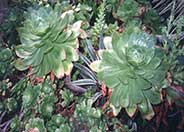
Common name:Aeonium cultivars
Botanical name:Aeonium cultivars
These plants are one of the most useful succulents, due to their decorative effects and sculpturesque quality. The branched stems hold a wide rosetta of either light green or purple leaves. The flowers appear in long, clustered form. They need some shade in hotter areas. Prostrate forms are low-growing, and spreading.

Common name:Orange Sedum
Botanical name:Sedum nussbaumeranian
This succulent perennial will grow best in a wall pot or hanging basket due to its long stems. It has light, gray green leaves that grow over one another to give off a "braided" look. The flowers are pink to deep red and bloom in spring and summer.
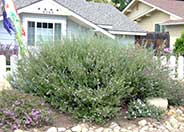
Common name:Australian Rosemary, Coast Rosemary
Botanical name:Westringia fruticosa
The Australian Rosemary is an evergreen shrub that grows 4'-6' tall. It has soft, gray green leaves and white flowers throughout the year and prefers sun and little to average amounts of water. This shrub is also drought tolerant.
Maintenance Tips
Westringia fruticosa is a fine-textured, evergreen shrub that grows 4-6' tall and 6-10' wide. Its common name is Coast Rosemary because the foliage resembles Rosemary. This plant will look and perform its best if it is given the space to reach its full mature size. The flowers bloom along the branches throughout the year in warmer climates so there is no need for deadheading. This shrub has a free-form growth habit so the thinning method is usually the best way to prune. Making pruning cuts towards the center will allow sunlight into the interior and will allow the plant to keep its free-form shape. If this shrub is being used as a formal hedge, it can be sheered to manage its shape and size without losing the blooming potential. It is a very tough plant, rarely suffering from pests or disease, and it can tolerate wind and sea spray.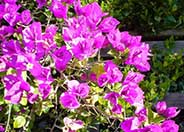
Common name:Bougainvillea selections
Botanical name:Bougainvillea cultivars
This species is hardy and vigorous, with a showy, ornamental display of purple color. It blooms well in areas with cool summers.
It is senstive to frost and will die back hard but comes back in a number of weeks. Be carefeul of this in the Santa Ynez Valley.
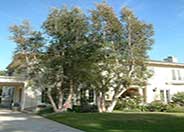
Common name:Paperbark Tree, Cajeput Tree
Botanical name:Melaleuca quinquenervia
Paperbark or Cajeput (Melaleuca quinquenervia) is an Australian native that is known for its beautiful, papery bark that unravels in sheets on the trunk. The tree can reach 40’ tall and 15’-25’ wide. It is often grown as a multi-trunk tree, and it makes a beautiful specimen tree in a wide range of garden styles. It is unparticular about its soil, and it can thrive in a wide range of moisture conditions. If this tree is selected for a small- to medium-sized garden, measures must be taken to keep topical roots from forming. Drip irrigation or deep, infrequent watering is best. If this tree is planted near an area with overhead sprinklers, root barriers may be necessary to keep roots away from the wetter parts of the garden. Once the tree reaches a size where it could benefit from some shaping, it is best to have a licensed arborist perform the work. This tree should be planted at least eight feet away from any hardscape areas, 15 feet from structures such as houses and buildings, and not near any powerlines. Shrubs and perennials should be planted about five feet away from this tree. It should be irrigated for about 45 minutes once a week when using most in-line drip irrigation systems.
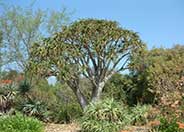
Common name:Baines Tree Aloe
Botanical name:Aloe barberae
This slow-growing tree has a heavy trunk with forking branches. It produces 2'-3' leaves in rosettes and rose/pink flowers.
Designer: N/A
Photographer: GardenSoft
Practice grass-cycling by leaving short grass clippings on lawns after mowing, so that nutrients and organic matter are returned to the soil.
Attract, or buy beneficial insects such as ladybugs and lacewings to control pest outbreaks in your garden.